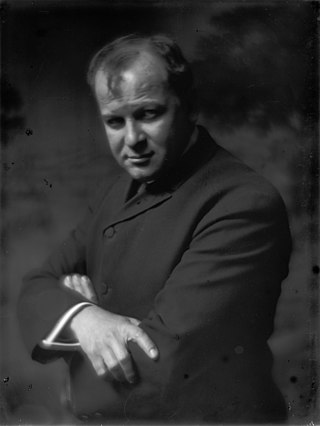
George Benjamin Luks was an American artist, identified with the aggressively realistic Ashcan School of American painting.
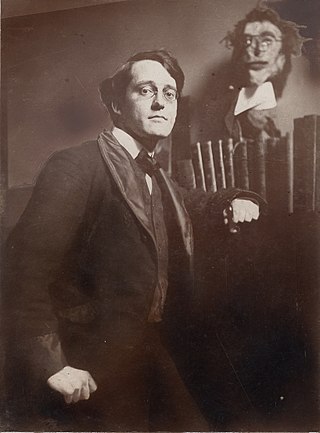
John French Sloan was an American painter and etcher. He is considered to be one of the founders of the Ashcan school of American art. He was also a member of the group known as The Eight. He is best known for his urban genre scenes and ability to capture the essence of neighborhood life in New York City, often observed through his Chelsea studio window. Sloan has been called the premier artist of the Ashcan School, and also a realist painter who embraced the principles of Socialism, though he himself disassociated his art from his politics.

The Ashcan School, also called the Ash Can School, was an artistic movement in the United States during the late 19th-early 20th century that produced works portraying scenes of daily life in New York, often in the city's poorer neighborhoods.

Luigi Carlo Filippo Russolo was an Italian Futurist painter, composer, builder of experimental musical instruments, and the author of the manifesto The Art of Noises (1913). Russolo completed his secondary education at Seminary of Portograuro in 1901, after which he moved to Milan and began gaining interest in the arts. He is often regarded as one of the first noise music experimental composers with his performances of noise music concerts in 1913–14 and then again after World War I, notably in Paris in 1921. He designed and constructed a number of noise-generating devices called Intonarumori.
Neo-expressionism is a style of late modernist or early-postmodern painting and sculpture that emerged in the late 1970s. Neo-expressionists were sometimes called Transavantgarde, Junge Wilde or Neue Wilden. It is characterized by intense subjectivity and rough handling of materials.

Robert Henri was an American painter and teacher.

The Pennsylvania Academy of the Fine Arts (PAFA) is a museum and private art school in Philadelphia, Pennsylvania. It was founded in 1805 and is the first and oldest art museum and art school in the United States.
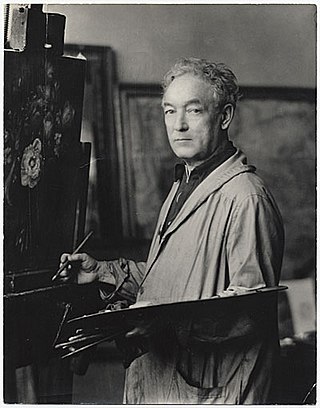
William James Glackens was an American realist painter and one of the founders of the Ashcan School, which rejected the formal boundaries of artistic beauty laid down by the conservative National Academy of Design. He is also known for his work in helping Albert C. Barnes to acquire the European paintings that form the nucleus of the famed Barnes Foundation in Philadelphia. His dark-hued, vibrantly painted street scenes and depictions of daily life in pre-WW I New York and Paris first established his reputation as a major artist. His later work was brighter in tone and showed the strong influence of Renoir. During much of his career as a painter, Glackens also worked as an illustrator for newspapers and magazines in Philadelphia and New York City.

Ernest Lawson was a Canadian-American painter and exhibited his work at the Canadian Art Club and as a member of the American group The Eight, artists who formed a loose association in 1908 to protest the narrowness of taste and restrictive exhibition policies of the conservative, powerful National Academy of Design. Though Lawson was primarily a landscape painter, he also painted a small number of realistic urban scenes. His painting style is heavily influenced by the art of John Henry Twachtman, J. Alden Weir, and Alfred Sisley. Though considered a Canadian-American Impressionist, Lawson falls stylistically between Impressionism and realism.

Bohumil Kubišta was a Czech painter and art critic, one of the founders of Czech modern painting. He studied at the Academy of Fine Arts in Prague, but left in 1906 to study at the Reale Istituto di Belle Arti in Florence. He, Emil Filla, Antonín Procházka, and five others founded Osma, an Expressionist-oriented group of artists.

Everett Shinn was an American painter and member of the urban realist Ashcan School.
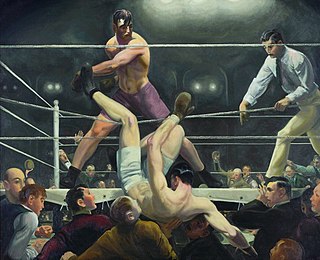
American Realism was a style in art, music and literature that depicted contemporary social realities and the lives and everyday activities of ordinary people. The movement began in literature in the mid-19th century, and became an important tendency in visual art in the early 20th century. Whether a cultural portrayal or a scenic view of downtown New York City, American realist works attempted to define what was real.

Thomas Pollock Anshutz was an American painter and teacher. Known for his portraiture and genre scenes, Anshutz was a co-founder of The Darby School. One of Thomas Eakins's most prominent students, he succeeded Eakins as director of drawing and painting classes at the Pennsylvania Academy of Fine Arts.
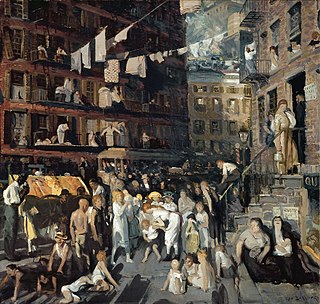
Cliff Dwellers (1913) is an oil-on-canvas painting by George Bellows that depicts a colorful crowd on New York City's Lower East Side, on what appears to be a hot summer day. Its dimensions are 40+1⁄4 by 42+1⁄8 inches, and it is in the collection of the Los Angeles County Museum of Art, which acquired it in 1916.

The Swimming Hole is an 1884–85 painting by the American artist Thomas Eakins (1844–1916), Goodrich catalog #190, in the collection of the Amon Carter Museum of American Art in Fort Worth, Texas. Executed in oil on canvas, it depicts six men swimming naked in a lake, and is considered a masterpiece of American painting. According to art historian Doreen Bolger it is "perhaps Eakins' most accomplished rendition of the nude figure", and has been called "the most finely designed of all his outdoor pictures". Since the Renaissance, the human body has been considered both the basis of artists' training and the most challenging subject to depict in art, and the nude was the centerpiece of Eakins' teaching program at the Pennsylvania Academy of the Fine Arts. For Eakins, this picture was an opportunity to display his mastery of the human form.
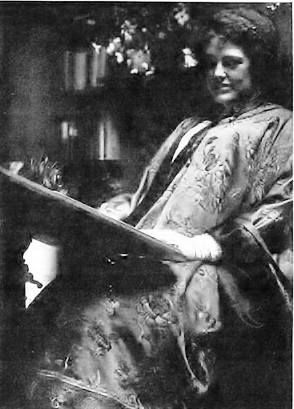
Mary (May) Wilson Watkins Preston was an American illustrator of books and magazines and an impressionist painter. She had an interest in art beginning in her teenage years, but her parents sent her to Oberlin College hoping that she would develop another interest. After three years, and at the urging of one of her teachers, Preston's parents allowed her to return to New York and attend the Art Students League. She then studied in Paris with James Whistler and next at the New York School of Art with William Merritt Chase.
James Moore Preston (1873–1962) was an American painter and illustrator, married to fellow artist May Wilson Preston. He was one of the Ashcan School, along with his friend, William Glackens.
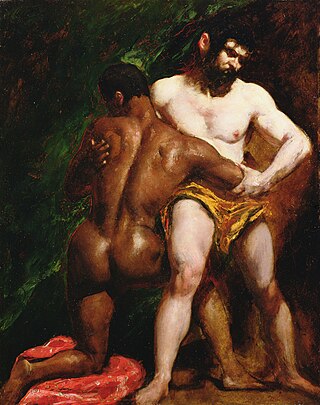
The Wrestlers is an oil painting on millboard by English artist William Etty, painted around 1840 and currently in the York Art Gallery, in York, England. It depicts a wrestling match between a black man and a white man, both glistening with sweat and under an intense light emphasising their curves and musculature. While little documentation of the painting exists prior to 1947, it is likely that it was painted over a period of three evenings at the life class of the Royal Academy.
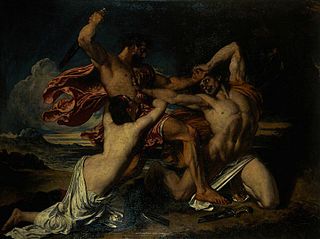
The Combat: Woman Pleading for the Vanquished is a large oil painting on canvas by English artist William Etty, first exhibited in 1825 and now in the National Gallery of Scotland. Inspired by the Elgin Marbles and intended by the artist to provide a moral lesson on "the beauty of mercy", it shows a near-nude warrior whose sword has broken, forced to his knees in front of another near-nude soldier who prepares to inflict a killing blow. A woman, also near-nude, clutches the victorious warrior to beg him for mercy. Very unusually for a history painting of the period, The Combat does not depict a scene from history, literature or religion and is not based on an existing artwork, but is instead a scene from the artist's own imagination.

The Macbeth Gallery was an art gallery in New York City that was the first to specialize in American art. Founded by William Macbeth in 1892, the gallery gained notoriety in 1908 when it put on an exhibition protesting the restrictive policies and conservative tastes of the existing art establishment in New York, exemplified by the National Academy of Design. The exhibition showcased the work of eight artists who were known for portraying gritty scenes of daily life, especially of poorer communities in New York: Robert Henri, William Glackens, George Luks, Everett Shinn, John Sloan, Arthur Bowen Davies, Ernest Lawson, and Maurice Prendergast. Though they had varying styles, the artists were later known collectively as "The Eight". Henri, Glackens, Luks, Shinn, and Sloan were associated with the Ashcan School, and the 1908 exhibition brought increased national attention to that movement and founded their reputations.


















